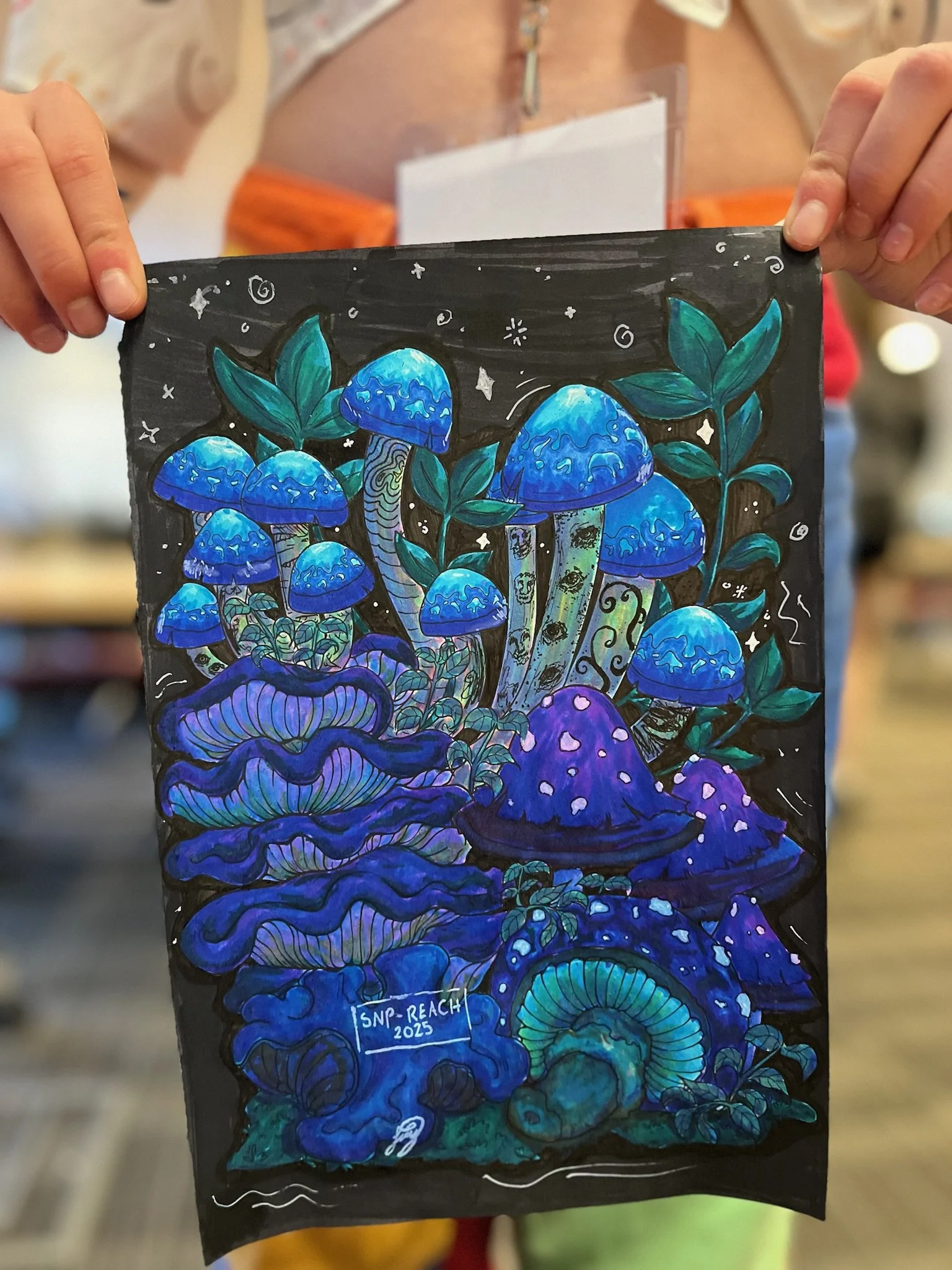11/04/2025
Rethinking “Flourishing” Through a Neurodiversity Lens
by Cassidy Miller
Flourishing is a complex concept with many facets. Seligman's PERMA model (2011) is one of the most commonly cited models of flourishing. The model suggests that flourishing occurs when a person experiences positive emotion, engages in meaningful tasks that promote flow, has positive relationships, has meaning and purpose in life, and makes important personal accomplishments. More recently, PERMA was expanded to PERMA-H in order to incorporate health into the framework of flourishing (Norrish & Seligman, 2015). Other models of flourishing exist, which have similarly operationalized it as inclusive of a person’s psychological, emotional, and social well-being (Diener et al., 2010; Keyes, 2002). The APA Dictionary of Psychology defines flourishing as “a condition denoting good mental and physical health: the state of being free from illness and distress but, more important, of being filled with vitality and functioning well in one’s personal and social life” (American Psychological Association, 2018).
But whose version of flourishing are we talking about?
The neurodiversity paradigm is a perspective that acknowledges neurodiversity, or neurologic differences (like autism, ADHD, dyslexia, etc.), as a “natural and valuable form of human diversity” (Walker, 2021, 00:57:38). It acknowledges the idea that a “normal” type of brain is a cultural construct, no more valid than the idea that there is one “right” ethnicity or gender. If one adheres to mainstream definitions of flourishing, which include “[living] within an optimal range of human functioning” (Frederickson & Losada, 2005, p. 678) and
“social-psychological prosperity” (Diener et al., 2010, p. 144), it may not be possible for all neurodivergent individuals to experience flourishing. The customary well-being metrics such as social connectedness, emotional regulation, extroversion, and the absence of “illness and distress” can marginalize neurodivergent experiences. For example, an autistic person may find joy in deep special interests rather than large social networks, but common measures of well-being would neglect an assessment of the valence and value of these special interests.
Cage et al. (2018) support the idea that well-being relates more to authenticity, not conformity to social norms. Camouflaging, also referred to as masking, is a strategy used by neurodivergent individuals to fit into neurotypical society. It includes concealing behaviors such as stimming[1], adapting facial expressions, and changing vocal patterns. While masking in unsafe environments can be a protective mechanism, chronic masking is correlated with higher rates of depression, anxiety, and burnout in autistic adults (e.g., Hull et al., 2017; Livingston et al., 2020). Although some aspects of masking may be more specific to autism, such as the suppression of stimming, many aspects of masking are experienced across neurotypes as a form of stigma management (Miller et al., 2021). In this context, stigma management refers to the use of strategies to minimize social stigma, discrimination, and exclusion by concealing traits that deviate from neurotypical expectations. This feeling of being disconnected from one’s true sense of identity is antithetical to flourishing, as it is currently defined.
So, what does flourishing look like for neurodivergent people? Let’s revisit the PERMA
Model to brainstorm a few ideas.
Positive Emotion. Traditionally, this domain includes experiences of joy, gratitude, serenity, hope, and other positive emotions. For neurodivergent folks, positive emotions may manifest in ways not recognized by others. Joy might stem from sensory experiences, special interests, or predictability and routine rather than spontaneity. Emotional regulation may look different, and calm after sensory overload may feel just as fulfilling as excitement (Kapp et al., 2019; Robertson, 2009).
Engagement & Flow. This is where many neurodivergent folks thrive! Hyperfocus is phenomenologically almost identical to flow, or deep absorption in meaningful tasks (Ashinoff & Abu-Akel, 2021). Some examples include writing, creating art, gaming, researching, or playing sports. Engagement can occur in unconventional ways, and environments that respect minimal interruptions and sensory safety can make flow more accessible; this is especially crucial, as transitioning out of a state of hyperfocus can be difficult.
Relationships. Just because social interaction may be challenging for some neurodivergent people, doesn’t mean that relationships and forms of support are not crucial components of their overall well-being (Najeeb & Quadt, 2024). Since camouflaging to maintain relationships can negatively impact well-being, neurodivergent people often value authenticity in a few relationships over the number of relationships they have. Connection with other neurodivergent folks is common, as there is often less pressure to follow social conventions. Meaningful one-on-one connections may matter more than broad networks; connection can be found in online communities, shared hobbies, or even quiet companionship.
Meaning. For some neurodivergent individuals, meaning may come from understanding and embracing their neurotype rather than fitting in. Many neurodivergent people find purpose in advocacy, creativity, or helping others navigate similar experiences; meaning may also come from structure, curiosity, or a moral commitment to justice and truth (Fung, 2024).
Accomplishment. While this domain is traditionally associated with external metrics–such as grades, promotions, and productivity–sometimes the invisible victories are more meaningful for neurodivergent folks. Self-defined goals like managing sensory environments and maintaining balance and energy throughout the day are important to highlight. Accomplishments like self-advocacy, recovering from burnout, and showing up authentically should be celebrated (Botha & Frost, 2020; Cage et al., 2018).
Health. In the expanded PERMA-H model, health refers to the bodily foundations that support flourishing, like sleep, nutrition, exercise, and energy. Seligman and Kern (2015) emphasize that flourishing depends on feeling physically well enough to pursue the other PERMA dimensions. Chronic stress from masking, sensory overwhelm, or social exclusion can manifest physically through fatigue and burnout; it is crucial to have the space to rest without guilt (Brodt & Lewis, 2024). For neurodivergent people, practices that support mental and sensory regulation (e.g. movement, sensory aids, rest, stimming, etc.) can be a part of health promotion.
Examining flourishing through a neurodiversity lens using the PERMA-H model requires expanding each domain to make space for different ways of feeling, thinking, and connecting. Broadening the operational definition of flourishing ultimately creates more space for everyone to flourish.
[1] Stimming refers to the repeating of movements, sounds, or sensory actions used to regulate the body and emotions, focus attention, communicate internal states, or simply because the actions feel pleasant (see Kapp et al., 2019).
References
American Psychological Association. (2018). Flourishing. In APA dictionary of psychology. Retrieved October 9, 2025, from https://dictionary.apa.org/flourishing Ashinoff, B.K., & Abu-Akel, A. (2021). Hyperfocus: The forgotten frontier of attention. Psychological Research, 85, 1–19. https://doi.org/10.1007/s00426-019-01245-8 Botha, M., & Frost, D. M. (2020). Extending the minority stress model to understand mental health problems experienced by the autistic population. Society and mental health, 10(1), 20-34. https://doi.org/10.1177/2156869318804297 Brodt, M., & Lewis, C. (2024). Beyond affirming: Expanding disability affirmative therapy using a case example. Practice Innovations, 9(4), 293–304. https://doi.org/10.1037/pri0000249 Cage, E., Di Monaco, J., & Newell, V. (2018). Experiences of autism acceptance and mental health in autistic adults. Journal of Autism and Developmental Disorders, 48(2), 473-484. https://doi.org/10.1007/s10803-017-3342-7 Diener, E., Wirtz, D., Tov, W., Kim-Prieto, C., Choi, D., Oishi, S., & Biswas-Diener, R. (2010). New well-being measures: Short scales to assess flourishing and positive and negative feelings. Social Indicators Research, 97(2), 143–156. https://doi.org/10.1007/s11205-009-9493-y Fredrickson, B. L., & Losada, M. F. (2005). Positive affect and the complex dynamics of human flourishing. American psychologist, 60(7), 678. https://doi.org/10.1037/0003-066X.60.7.678 Fung, L. (2024). Strengths-based models and neurodiversity. In E. Patton & A. M. Santuzzi (Eds.), Neurodiversity and work (pp. 39-59). Palgrave Macmillan. https://doi.org/10.1007/978-3-031-55072-0_3 Hull, L., Mandy, W., Lai, M. C., Baron-Cohen, S., Allison, C., Smith, P., & Petrides, K. V. (2019). Development and validation of the camouflaging autistic traits questionnaire (CAT-Q). Journal of Autism and Developmental Disorders, 49(3), 819-833. https://doi.org/10.1007/s10803-018-3792-6 Kapp, S. K., Steward, R., Crane, L., Elliott, D., Elphick, C., Pellicano, E., & Russell, G. (2019). ‘People should be allowed to do what they like’: Autistic adults’ views and experiences of stimming. Autism, 23(7), 1782-1792. https://doi.org/10.1177/1362361319829628 Keyes, C. L. M. (2002). The mental health continuum: From languishing to flourishing in life. Journal of Health and Social Behavior, 43(2), 207–222. https://doi.org/10.2307/3090197 Miller, D., Rees, J., & Pearson, A. (2021). “Masking is life”: Experiences of masking in autistic and nonautistic adults. Autism in adulthood, 3(4), 330-338. https://doi.org/10.1089/aut.2020.0083 Najeeb, P., & Quadt, L. (2024). Autistic well-being: A scoping review of scientific studies from a neurodiversity-affirmative perspective. Neurodiversity, 2. https://doi.org/10.1177/27546330241233088 Norrish, J. M., & Seligman, M. E. (2015). Positive education: The Geelong grammar school journey. Oxford University Press. Robertson, S. M. (2010). Neurodiversity, quality of life, and autistic adults: Shifting research and professional focuses onto real-life challenges. Disability Studies Quarterly, 30(1). https://doi.org/10.18061/dsq.v30i1.1069 Seligman, M. E. P. (2011). Flourish: A visionary new understanding of happiness and well-being. New York, NY: Free Press. Walker, N. (2021). Neuroqueer heresies: Notes on the neurodiversity paradigm, autistic empowerment, and postnormal possibilities (Narrated by Nick Walker) [Audiobook]. Autonomous Press. 

